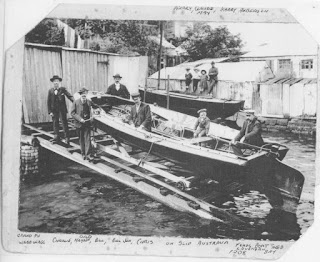Charles "Charlie" Webb-Wagg (1862 to 1939) -The fifth child of William (Bill) and Sarah Wagg
On this day in 1939, Charles Webb-Wagg died at his residence at 15 Johnson Street, Chatswood. Known as Charles or Charlie, he is second on the left in this photo.
There have been many references to Charles over the recent weeks - with the two Clancy sisters marrying the two Webb Wagg brothers, Mary Foy going over on Charlie's houseboat (and discussing Chris Webb and Claude and Hazel Webb over in Adelaide) and his being an informant on many of the death registrations of both Webb Waggs and Tricketts.
My mum always talked about "Uncle Charlie" with affections even though she was only eleven when he died.
The Sydney Morning Herald of 17 May 1939 records:-
"Mr Charles Webb-Wagg, who died at his residence, Chatswood, at the age of 78, had lived in North Sydney nearly all his life. An employee of the Sydney Ferries Ltd. for the whole of his working years, he was a master in the vehicular ferry service between Dawes Point and Blue's Point until this was discontinued with the opening of the Harbour Bridge."
OBITUARY. (1939, May 17). The Sydney Morning Herald (NSW : 1842 - 1954), p. 9. Retrieved May 8, 2017, from http://nla.gov.au/nla.news-article17587316
A bit of quick calculating and Charlie was working when he was over 70!
Thanks to the magic of trove.nla.gov.au, I've been able to find this photo dated 26 March 1925-
 |
|
Was Charlie the captain?
The Kalang
This ship model represents the 'Kalang' when she operated as a vehicular ferry between Dawes Point and Milsons Point (1926-1932). At this time, vehicular ferries provided the only means of transport for passengers and their cars between the north and south sides of Sydney Harbour until the opening of the Sydney Harbour Bridge in 1932. The advent of the bridge meant vehicular ferries were no longer needed and in effect, the 'Kalang' was temporarily laid up for six years, before being converted by her owners, Sydney Ferries Ltd, into a showboat. The 'Kalang' marked the beginning of the success of showboats on Sydney Harbour, providing tourists and locals with excursions around Sydney Harbour; cabaret shows; dancing and other forms of entertainment. Her morning route took her under the Sydney Harbour Bridge into Lane Cove River and the Parramatta River as far as Mortlake, while her afternoon route departed Circular Quay for the south shore of Sydney Harbour, under the Spit Bridge, through Middle Harbour and across to Killarney picnic ground. The 'Kalang' spent around 17 years as a showboat, interrupted by several years in service for the Royal Australian Navy, while she assisted in the war efforts. This particular ship model provides a sound small-scale representation of the 'Kalang' during her early years in use, helping to show the intricate details of the vessel's form, its method of propulsion and deck area. The model also acts as a legacy for the full-scale version which no longer survives. The 'Kalang' was wrecked near Kempsey on her way to the Philippines in 1972. References Allen, G., "The Five Faces of the Sydney Queen" in The Sun Herald (July 12, 1970) Andrews, G., "A Pictorial History of Ferries: Sydney and Surrounding Waterways" (Sydney, 1982) Andrews, G., "The Ferries of Sydney" (Sydney, 1975) Hastings, B., "Our Ferries' Finest Hour" in The Sun (Thursday, May 29, 1986) MacDougall, M., "Showboat of Port Jackson" in Port of Sydney, no.6 (October 1953)





